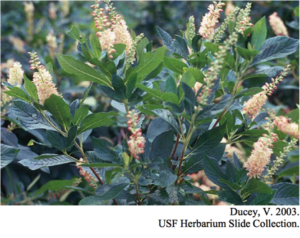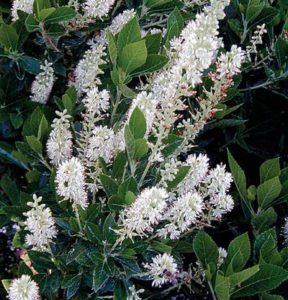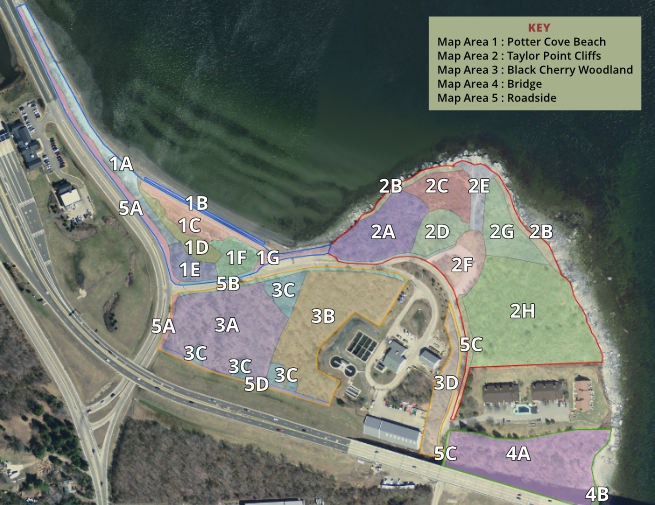Common Name: Coastal Sweet-Pepperbush
Specific Name: Clethra alnifolia
Known Occurrence at Taylor Point:
Map areas: Cliffs 2C
Category: Native, Shrub

Ecological Considerations:
Clethra alnifolia, commonly known as coastal sweet-pepperbush, is a large deciduous shrub that grows to 2.5 m tall. The bark is smooth, reddish- orange or gray in color, and 2 to 3 mm in diameter. Twigs are reddish-orange covered with dense white hairs. Leaves are alternate, simple, 5 to 8 cm long, and toothed toward their tips. They are medium to dark green, turn golden yellow in the fall and have white hairs pressed closely against along the mid-vein. Flowers are up to 1 mm long and 0.8 mm wide, composed of 5 white fused petals. Seventeen to one hundred fragrant flowers form the bottlebrush-like inflorescences that are about 10 cm long and 2 cm wide. The fruiting stalk has many miniature oval 3- seeded capsules that are winter-persistent and are good identification features. Coastal sweet pepperbush produces leaves in late spring, flowers in July and August, and sets fruit in September and October. The yellow fall foliage persists for two to four weeks.
Map areas where this plant can be used for re-vegetation:
none
Propagation Mechanisms/Strategies for Encouraging its Establishment:
Coastal sweet pepperbush can be propagated by seeds, summer cuttings, or sucker division.
Best Planting Practices/Options and Pros and Cons of Options:
Coastal sweet pepperbush is found in wet woods, thickets, marshes, and near rocks in water. It can be used for erosion control in these areas. It is typically not a dominant species in plant communities.
It grows naturally in poorly drained, moist soils and will get larger and produce more suckers if provided plenty of water. Once established, it can also thrive on drier, well-drained soils. The optimum soil pH is approximately 4.5. Coastal sweet pepperbush is moderately salt tolerant and can be grown near, but not directly behind, beaches.
Coastal sweet pepperbush is a shade-tolerant understory shrub that grows under the canopy of old- growth trees. It will grow in full sun, but does best in a light, dappled shade.
Key Issues Regarding its Ecology
Associated Ecological Benefits:
Erosion control: Coastal sweet pepperbush spreads by sending up new shoots, forming a thicket of low bushes. Growth from root suckering will provide moderate erosion control along streams and ponds. Coastal sweet pepperbush is sometimes used to halt succession of tall trees along pathways.
The fragrant white flowers and nectar of coastal sweet pepperbush attract hummingbirds and butterflies. Deer eat it only when other forage vegetation is limited. Birds eat the fruit and aid in seed dispersal.
Availability of Locally Sourced Seeds and Plants:
Evergreen Tree & Landscape info
The Farmer’s Daughter info
Wildwood Nurseries info
Rhody Native info
Stewart Nursery
Case Studies of Native Plant Establishment Efforts/Lessons Learned:
Additional photos:


Sources cited:
Rhode Island Native Plant Guide
USDA Plant guide
Go Botany
Key Words:
Native,
Shrub,
Non-Invasive
Clethra alnifolia
Coastal Sweet-pepperbush
